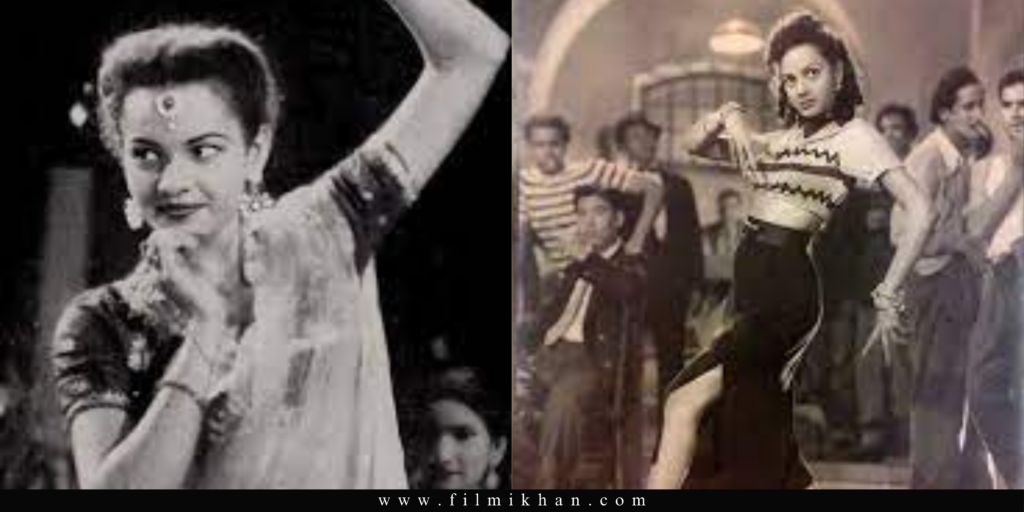In the golden era of Hindi cinema, one name shone brightly on the silver screen, leaving an indelible mark on the hearts of audiences – Cuckoo Moray. Beyond her mesmerizing performances as an actress, Cuckoo’s prowess as a dancer added an extra layer of enchantment to her illustrious career.

Early Life and Introduction to Showbiz:
She was born on February 4, 1928 into a family with a rich cultural background, Cuckoo Moray’s journey into the world of entertainment began at a young age. Raised in the vibrant tapestry of Indian arts, she discovered her passion for dance, showcasing an innate talent that would later blossom into a celebrated career. She was the queen of film dancing in Hindi films of the 1940s and 1950s.
cuckoo was famous as “Rubber Girl” in the film industry. She made cabaret dancing a must in the Hindi films during the 1940s and 1950s. Hindi films were incomplete without Cuckoo’s dance numbers during those days. Her real name was Cuckoo Moray.
Dancing into Stardom:
Cuckoo’s early foray into the world of dance led her to the silver screen, where her grace, charm, and unparalleled dancing skills quickly gained attention. From classical to contemporary, Cuckoo Moray seamlessly blended various dance forms, earning her a distinct place in the hearts of audiences and filmmakers alike. Her performances became iconic, with each dance number etching itself into the collective memory of Indian cinema enthusiasts.
She started her career in Hindi film industry in the film Arab Ka Sitara in 1946. Soon after she was noticed in Stum Chandi, director and greater audience marked her dancing abilities for the first time. Then, the turning point came in her cine-career when she signed Mahboob Khan’s film Anokhi Ada (1948), a dancing number in this film made her sensation over night and made her leading dancer of the era. She used to take more fees than leading actress for a dance sequence.
Later she appeared in Andaz (1949), a romantic film starring Naris, Dilip Kumar and Raaj Kapoor, she appeared in cameo. She had a short cameo in a dance sequence in Mehboob Khan’s 1952 technicolour film Aan which was her first colour film. She did only two-colour films in her whole career Aan and Mayurpankh. She would charge 6000 Rs. For a dance number, an enviable fee in the 50s.

Cinematic Journey:
Cuckoo Moray’s cinematic journey took flight during the 1950s and 1960s, a period often referred to as the “Golden Age of Hindi Cinema.” With her radiant presence and charismatic performances, she graced numerous films, sharing the screen with legendary actors of her time. Whether portraying the vivacious dancer in musical extravaganzas or delivering poignant performances in dramatic roles, Cuckoo Moray showcased versatility that set her apart in the industry.
She abides the primary place in dancing in Hindi cinema until dancers such as Helen and Vyjanthimala came into films. Cuckoo was family friend of the Anglo-Burmese dancer Helen and helped her to established in film industry. She was known for helping struggling actors get their break in film industry, such as Pran in film Ziddi. Cuckoo had introduced a 13 years old girl Helen as a chorus dancer into films like Shabistan and Awara (1951). Heren and Cuckoo appeared in dance sequences together such as Chalti Ka Naam Gaadi and Yahudi (1958). Cuckoo’s last was ‘Mujhe Jeene Do’ released in 1963, after which she disappeared from the films.
Cuckoo died on September 30, 1981 due to cancer at the age of 53.
Trailblazing Dance Numbers:
Cuckoo’s dance sequences became legendary, setting a standard for grace and artistry in Indian cinema. From the spirited “Ek do Teen Aja Mausam Hai Rangeen” to the soul-stirring “Hum tumhare Zara Ghar Se Nikal Ke Dekho,” each dance number was a testament to her dedication and innovation in the realm of choreography. Her ability to seamlessly merge classical and contemporary dance forms left an enduring impact on Bollywood dance.
Legacy and Influence:
Beyond the arc lights and applause, Cuckoo Moray’s legacy endures as an inspiration to aspiring dancers and actors. Her contributions to the cinematic and dance landscape continue to shape the industry, and her name remains synonymous with the glamour and artistry of a bygone era.
Retirement and Later Years:
As the curtains closed on her cinematic career, Cuckoo Moray gracefully transitioned to a quieter life, leaving behind a body of work that immortalized her in the annals of Indian cinema. Her later years were marked by a fond remembrance from fans and the industry, acknowledging her significant impact on the art forms she so passionately embraced.
2 thoughts on “Cuckoo Moray: queen of dancing in Hindi films of the 1940s and 1950s.”